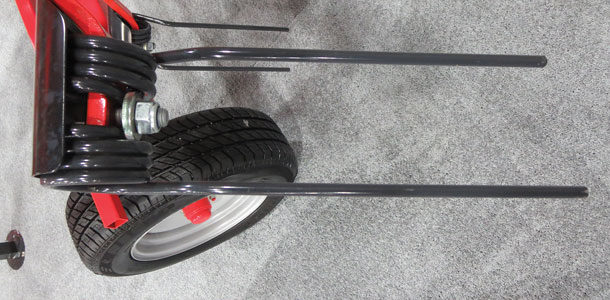Although these machines are not as costly as your baler may be, they still play a very important role in your hay operation.
Your tedder is essential in helping you get your hay crop dried down quickly. It is primarily used to spread the recently cut crop as wide as possible and invert it in order to expose it to maximum airflow and light contact.
Typically, the best time to ted is shortly after cutting – depending on the type of crop and current weather conditions. Tedders can potentially save many hours of drying time if properly used and maintained. Quick drydown is crucial in preserving high-quality hay for your operation.
Your rotary rake is essential for gathering, turning and forming nice windrows in order for the baler or chopper to be as efficient as possible.
Rotary rakes will usually result in less ash content in the hay as compared to wheel rakes because a rotary rake should not be in contact with the ground in the way that a wheel rake must.
A rotary rake picks up the hay and moves it to the windrow. This process of picking up the hay and moving it eliminates the roping action of the hay.
Since the crop is picked up off the stubble, the resulting windrow is very fluffy and uniform, allowing for better air movement, quick drydown and increased baler or chopper efficiency.
Most people will perform the regular grease maintenance on their tedder and rotary rake. Winter downtime is the perfect opportunity to check over the rest of these machines and assure that when it’s hay-making time, you’re ready to pull them out of the shed without any headache. Here’s a checklist of the other annual maintenance tasks you should be completing.
- Clean the machine by removing any dirt and dust, which can collect moisture and in turn cause rust. Any damaged areas of paint work should be touched up to minimize the possibility of rust.
Be sure to remove any foreign objects, such as hay, wire or twine, from the rotors and rotor undercarriages or wheels.
- Check to make sure all nuts and bolts are properly tightened. If some are loose, torque them to the appropriate setting shown in the operator’s manual.
- Check to make sure all safety guards are in place and in proper working order. If any guards are damaged or missing, fix or replace them before putting the machine into service.
- Check all gearboxes to be sure there is adequate oil in them. If the gearboxes are low in oil or are in need of changing, refer to the operator’s manual for proper amounts and types of oil.
- Inspect all hydraulic hoses, fittings and cylinders for leaks or cracks. If any leaks or cracks are found, replace with an equal part before using.
- Examine all tires on the machine for weather checks and pressure. Be sure to inspect the valve stem for any weather checks as well.
If the tires are in good shape, fill them to the appropriate pressure shown in the operator’s manual. If the tires need to be replaced or repaired, do so before using them.
- Check all PTO yokes for play or wear. If there is any play, be sure to have them replaced before use to avoid a more costly repair further down the road.
- Inspect all bearings for tightness, proper greasing and seal. If the bearings are loose, there is inadequate grease in the bearing, or there is a bad seal, have the issue corrected or replaced before operation.
- Check all tines to make sure they are in good working order. Any damaged or worn tines should be replaced before use.
Making these inspections on your tedder and rotary rake during the winter will save you valuable time in the spring and summer by reducing the possibilities for breakdowns. FG










